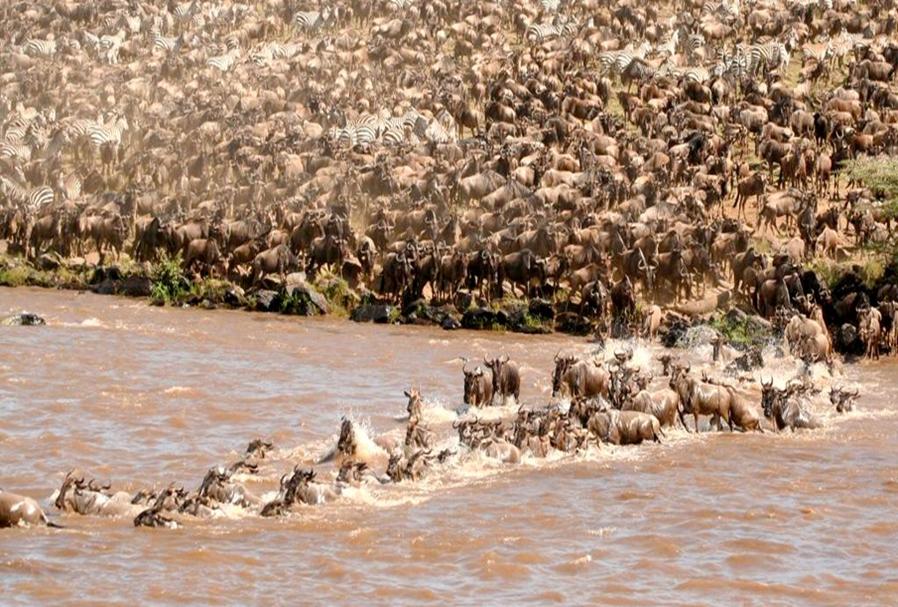The Great Annual Wildebeest Migration is the annual natural mass movement of over 1.7 millions of Wildebeests, accompanied by over 800,000 of Zebra, and smaller numbers of Grant’s Gazelle, Thompson’s Gazelle, Eland and Impala. They are migrating throughout the year constantly (approximately 1243 miles/2000kms) seeking fresh grazing with high level of Phosphorus and Nitrogen and, it’s now thought, better quality water. Predators follow the Wildebeest Migration closely, waiting for an opportunity to strike weak prey as they make their way into different territories.
The Migration is a spontaneous natural event and the timing changes month by month; year by year, depending on the weather and when the rains start. Therefore there can be no guarantee in advance where the annual migration will be at any specific time.
If you are in the Masai Mara you can expect the wildebeest to make their arrival as early as July, but they generally arrive between August & September and remain in the Masai Mara between October & November. Between the end of November and January the wildebeest gradually begin their migration from the Masai Mara back towards the Serengeti.
The best time to go on safari and witness the event in Serengeti National Park is December to February and from May to July.
In December the migrating Zebra’s begin to give birth in the northern part of the Serengeti and from late January through to about middle of March, is the Wildebeest calving season, when large herds tend to concentrate in the Southern Serengeti National Park spilling over to the Ngorongoro Conservation Area. During these months, the plains with their new fresh, abundant short-grass provide the perfect feeding ground for migrating animals to stay for about 10 – 12 weeks.
The Predators such as lion, cheetah, leopard and hunting dogs with vultures circling overhead, never far away as there is always the chance of an easy hunt on a newly born or young Wildebeest, Zebra or even a Gazelle. This is the prime time for a safari in the Serengeti.
During the months of April or early May the migration is due to be in the south-western region of the Serengeti. At this time the area is extremely wet with many roads being impassable, these 2 months is not recommended for Migration viewing
However, afterwards, June and July is generally a perfect time to catch the wildlife migrating along the Western Corridor, slowly heading northwards. And come August the Migration in right in the north, heading in Kenya.
THE GREAT ANNUAL WILDEBEEST MIGRATION MONTH TO MONTH TIMETABLE
The Migration Monthly Timetable is to be used as a Guide. The Migration Pattern varies from one year to the next, as it all depends on the start of the rains.
JANUARY
The migration is concentrated in the south-eastern Serengeti National Park, spilling over into the Ngorongoro Crater – the wildebeest start to give birth
FEBRUARY
The short-grass plains are the main feeding ground for over 1.7 million wildebeest, 800,000 zebra and many gazelle. Predators follow close by, feeding on the newly born. There is plenty of food for the predators at this time. This is the main month for wildebeest births. The great herds are on the move towards the Ndutu Woodlands. This month is also known as the calving season.
MARCH
The commencement of long and heavy rains is the time when the fresh grass is now depleted from several months of grazing and newborn wildebeest are strong enough to move and keep up with the migration. Now is when the migration heads west wards towards Maswa Game reserve in search of better grazing.
APRIL/MAY
Heaviest rainy month and the herds are in the Maswa area, with the Wildebeest being almost evenly scattered in the region, although it is not a great month to view them as the region is very wet and roads are often impassable.
JUNE
Rains comes to an end and the herds start migrating northward, crossing the Grumeti River, where many wildebeest and zebra lose their lives every year, but provide a yearly feast for the huge crocodiles who wait at the popular crossing points. This is a popular time for sighting the large cats. July /August All going on schedule, the migration should now be in the northern Serengeti crossing over to Kenya’s Masai Mara.
JULY/AUGUST
Regarded as the best months to see the River Crossing on the Mara River from Masai Mara, offering fantastic photographic opportunities.
SEPTEMBER
The migration should now be in Kenya’s Masai Mara Nature Reserve just across the northern border from the Serengeti National Park. This is the best said to be the best time to visit Masai Mara.
OCTOBER
The time when Maasai Mara Nature Reserve having plentiful supplies of water and good grazing, hence a popular month to view the great herds in the Masai Mara.
NOVEMBER
If the short rains come this month, the migrating herds of Wildebeest, Zebra and Gazelle will start to head southwards, out of the Masai Mara National Reserve, crossing Kenya’s border into Tanzania‘s Serengeti National Park.
DECEMBER
Usually the migration will now be arriving on Serengeti’s Southern plains, where there is abundance of new, fresh young grass to feed on. When the migration heads southward to Southern Serengeti, the migrating zebras begin to give birth.

